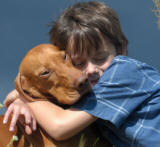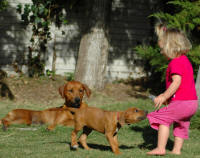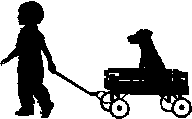Rough treatment is never
allowed
 Demonstrate to children how to
be gentle with dogs. One way is for the adult to
control
the
treats while the child is instructed how to give the
dog a gentle massage.
Demonstrate to children how to
be gentle with dogs. One way is for the adult to
control
the
treats while the child is instructed how to give the
dog a gentle massage.
Teach children to respect pets as
a different species including instruction on how to avoid
being bitten by a dog. One way to teach children how
to avoid being bitten is to practice falling like a tree, acting like a rock.
Have children show you how they would roll into
a ball, face down with hands covering their necks.
Instruct children not to stare or scream.
Read more.
click
here
Never
tolerate rough treatment
of pets. Help children
understand that
cartoons with dogs damaged
and bouncing back to normal, are
not real. Otherwise,
children may act out what they
see on television harming the dog and risking being harmed by the
dog.
|
Pets are wonderful to hug if
they are comfortable and
trusting around children.
One bad experience can make
a dog want to avoid
children, even become
aggressive around them.
|
 As
a rule of thumb, supervise
children and dogs. At the
parent's discretion, older
children who have received good
instructions and have proven
reliable may be safe alone with
the family dog.
As
a rule of thumb, supervise
children and dogs. At the
parent's discretion, older
children who have received good
instructions and have proven
reliable may be safe alone with
the family dog.
The more the child learns
how to correctly interact with
the dog the better. Involve
children in the dog's training
so the dog sees the child as
king or queen of the kingdom who
insists the dog earn everything
by following instructions such
as sit, down, roll over, shake,
etc.
Hide and Seek
One of the best
games for children to play with
a trained dog is hide-and-seek.
The dog must know how to "Sit-Stay"
for this game. The child tells
the dog to
"Sit-Stay"
or "Down-Stay"
then runs and hides
with a piece of food. When he or
she hollers, "Come",
the dog finds the child and gets
the treat.
Read more...click here.
Fetch
Fetch
is a great game. Instruct the child
to increase the dog's interest in the
ball by first bouncing it (or squeaking
a toy) it in front of the dog. Instruct
the child to praise the dog for fetching
and then throw a second ball or toy
until the dog learns to "give" the ball.
Use a treat to teach "give" until the
dog is reinforced by the enjoyment of
the game, Taking
the ball away may be perceived by the
dog as a punishment for doing the right
thing and make the dog stop bringing
things back. When the dog brings a toy
back, give the dog a back rub and really
praise the dog before asking for the
object. Show the dog a second object if
needed.
Some dogs do not
want to bring th e ball back. If the dog is at a
distance from you playing with the ball, produce the
second ball and begin bouncing and having fun with
it.
e ball back. If the dog is at a
distance from you playing with the ball, produce the
second ball and begin bouncing and having fun with
it.
Dogs tend to think whatever YOU have is better
than what THEY have. Use the "Come" instruction to
encourage the dog to come all the way back with the
ball in his or her mouth. At first, the dog may drop
the ball. Usually, the dog will learn over time - if praised until
the ball drops - to bring the ball all the way back.